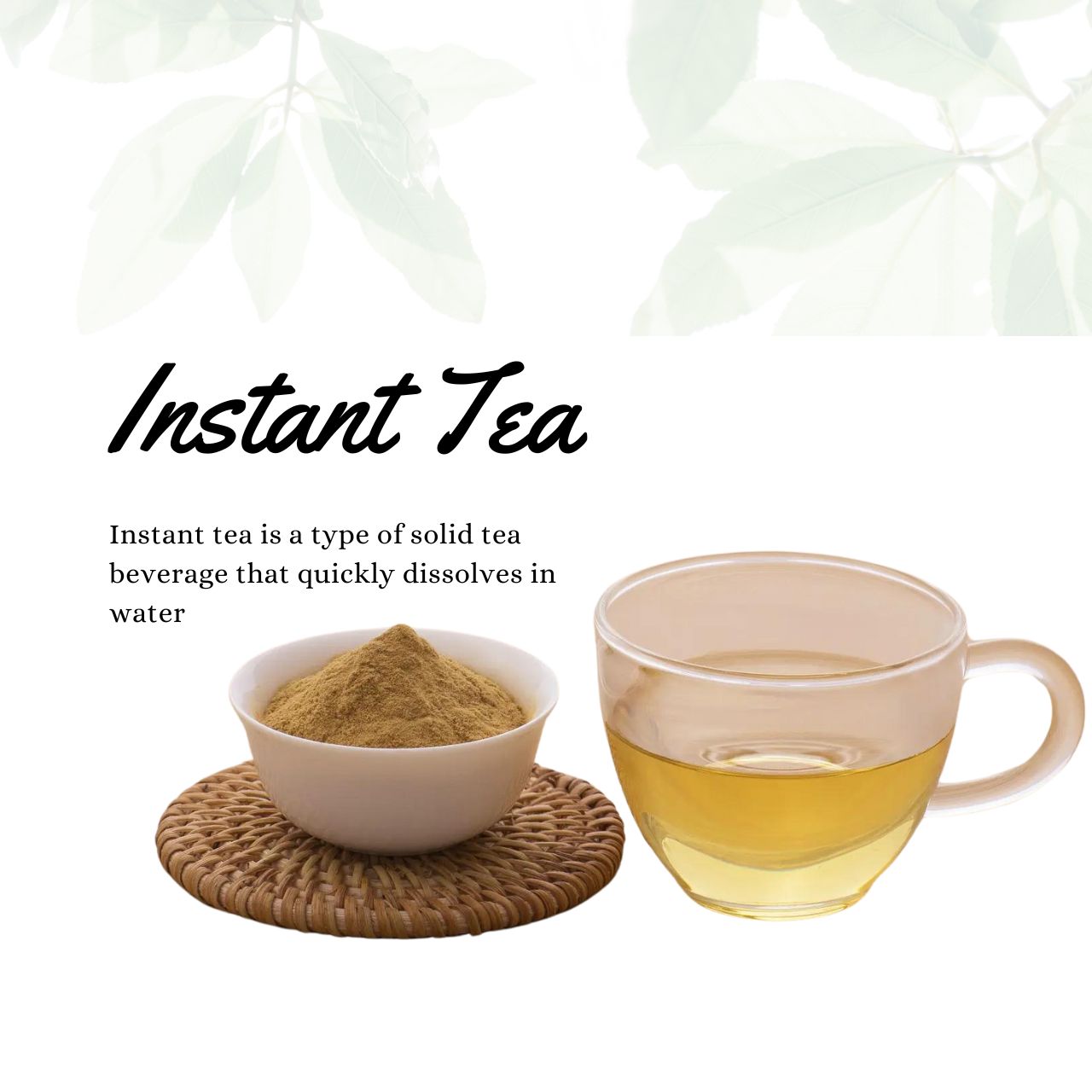Instant tea is a type of solid tea beverage that quickly dissolves in water. Using finished tea, semi-finished tea, tea by-products, or fresh leaves as raw materials, it undergoes processes such as extraction, filtration, concentration, and drying to produce a new type of beverage in granular, powdered, or small flake form that easily dissolves in water without leaving tea residue. It boasts advantages such as convenience in preparation, absence of pesticide residues, and versatility in flavors, including pure teas like instant black tea, green tea, Tieguanyin, oolong tea, jasmine tea, pu-erh tea, as well as flavored teas like lemon black tea, milk tea, and various fruit-flavored instant teas.
Introduction:
Instant teas are categorized into cold-soluble and hot-soluble types based on their solubility. Internationally, the price of instant tea is about 10 times that of dry tea. Consumption tends to be higher in developed countries; for instance, in the United States, consumption accounts for about one-third of total tea consumption, amounting to approximately 30,000 tons annually. The development of instant tea in China began in the 1970s in cities like Shanghai, Changsha, and Hangzhou and has since gained momentum. The rapid development of instant tea can be attributed to its inherent characteristics.
As a deep-processed tea product, benefits from a wide range of raw material sources, is not limited by geographical origins, and can be produced using both mid-to-low-grade finished teas and fresh leaves or semi-finished products, facilitating production in both tea-producing and non-tea-producing countries. The products can be consumed directly or mixed with fruit juice, sugar, and other ingredients to meet diverse consumer preferences. They also meet food safety requirements, with heavy metals, sand, and pesticide residues in the raw materials being removed during the processing, resulting in a relatively pure beverage. Production of instant tea can easily achieve mechanization, automation, and continuity. With its compact size, sturdy packaging, lightweight, and convenience in consumption, instant tea suits the fast-paced lifestyle of modern times.
Process:
The manufacturing process of instant tea includes water treatment, material selection, infusion, filtration, purification, concentration, ingredient blending, and drying. Instant tea processing involves advanced technology to overcome challenges such as poor solubility, susceptibility to moisture, and loss of tea aroma during concentration and drying. Since concentration and drying are critical production stages, traditional hot concentration methods can lead to the loss of tea aroma and browning of tea soup. Therefore, research has been conducted on the application of ambient temperature membrane concentration technology, which has shown promising results. This method involves using a semi-permeable membrane with controlled porosity to allow only water molecules to pass through while retaining tea solids, thereby achieving the desired concentration.
Methods:
There are two methods for drying instant tea: spray drying and freeze drying. In spray drying, carbon dioxide is introduced into the tea soup to create tiny bubbles. During spray drying, the carbon dioxide gasifies, forming small particles with hollow centers, which enhances solubility. For instant teas with added sugar or fruit juice, boiling or freeze-drying methods may be employed, similar to the production of powdered milk. Freeze drying involves lowering the temperature of the tea soup to below freezing, gradually increasing the temperature while reducing pressure to remove sublimated moisture. Instant tea produced using freeze drying has a loose texture and excellent solubility, suitable for both hot and cold preparations.
Craft:
The aerosol liquid instant tea beverage adopts a new canning technology, which improves or optimizes the preservation of various instant beverages, especially instant tea beverages, making them convenient for consumption. In China, the development and production of instant tea began in the late 1970s and early 1980s in cities such as Shanghai, Changsha, and Hangzhou. Initially, vacuum freeze-drying and spray-drying products were developed, each with its own characteristics. Vacuum freeze-dried products, processed at low temperatures, retain the aroma of tea with minimal loss but have long drying times, high energy consumption, and high costs. In contrast, spray-dried products undergo rapid drying at high temperatures, resulting in the loss of aromatic substances. However, they have a granular shape, good flowability, and lower costs. Due to the higher drying costs associated with vacuum freeze-drying, both domestic and international instant tea production predominantly uses the spray drying method. The processing technology and equipment for instant tea mainly consist of extraction, concentration, and drying parts. Extraction involves using water as a solvent to extract soluble substances from tea leaves. Methods include boiling water extraction, percolation extraction, and continuous extraction, with the latter achieving higher concentrations (15-20%). Concentration methods such as vacuum concentration, freeze concentration, and membrane concentration are widely used in the food industry. These methods exploit differences in the distribution of solutes and solvents to obtain concentrated solutions of varying concentrations. To preserve the quality of tea leaves and ensure food safety, it is essential to minimize heating time and temperature during the concentration process, often achieved by operating under low pressure. Currently, vacuum concentration and membrane concentration methods are most commonly used in instant tea production as they do not involve heating or evaporation, thereby preserving the quality of tea leaves.








